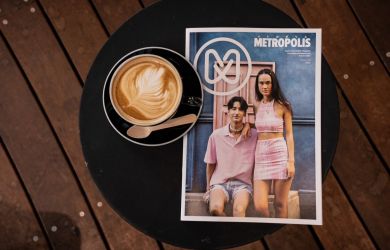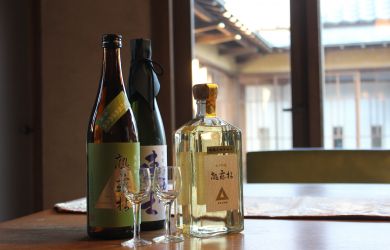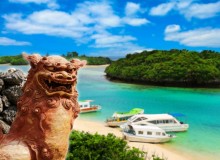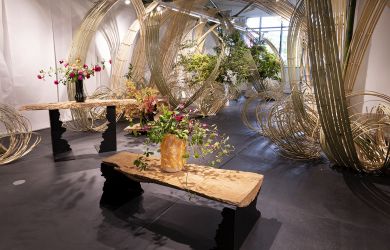
April 24, 2009
Yamate Seven Lucky Gods Walk
Follow an Edo-style path to good fortune in Meguro
By Metropolis
Originally published on metropolis.co.jp on April 2009

Illustration by Kohji Shiiki
Feeling a little down on your luck? Had your hedge funds wiped out by the unpleasantness of the last year? Here’s a traditional way to restore your fortune in just two or three hours.
Since the Edo period, pilgrimages honoring the seven lucky gods of Japanese folklore have been a popular way of assuring one’s luck at New Year. The pilgrim completes a fixed course of temples, collecting stamps or tokens symbolizing each of the gods along the way. In Tokyo alone, there are 24 such routes—the oldest of which, known as the Yamate course, runs through Meguro-ku. Unlike many other such trails, stamps and tokens are provided to pilgrims year-round, meaning that you won’t have to wait until next January to give your fortune a much-needed boost.
Kakurinji 覚林寺
Also known as Seishoko, this Nichiren sect temple was founded in 1631 and honors the great warrior Kato Kiyomasa, lord of Kumamoto Castle and invader of Korea. Predictably, the lucky god that is worshipped here is Bishamonten, the god of war and warriors.
1-1-47 Shirokanedai, Meguro-ku
Zuishoji 瑞聖寺
Founded in 1670, this was Edo’s first Zen temple of the Obaku sect, one of the three main schools of Buddhism in Japan. The current building dates back to the early 19th century, but the serene atmosphere feels much older. The lucky god to collect here is Hotei, the god of happiness and contentment, sometimes called the Fat Buddha. You can see a large black statue of him through the temple door on the far right.
3-2-19 Shirokanedai, Meguro-ku
Myoenji 妙円寺
This temple houses two gods, Jurojin and Fukurokuju. The former is the deity of longevity, while the latter’s name literally means fortune (fuku), happiness (roku) and longevity (ju). With their flowing beards and overlapping job descriptions, the two—understandably—are frequently confused. If you have time, take a stroll through the cemetery at the back of the temple, which features a number of excellent statues.
3-17-5 Shirokanedai, Meguro-ku

Photo by Vicki L. Beyer
Daienji 大円寺
Founded in 1624 and purportedly the flashpoint of the 1772 Great Gyonin-zaka Fire, this small temple offers an amazing array of gods. In addition to being able to collect your stamp or figurine of Daikoku (the god of wealth, farmers and the kitchen), you’ll also find statues of all seven lucky gods, several Jizo figures, the three monkeys of “see no evil, hear no evil, speak no evil” fame, and, inside the temple, a life-size Buddha. Just in front of the main temple is a statue of a seated Nyorai Buddha with an interesting function: rub gold leaf onto the part of his body corresponding with the part of your body that’s ailing you, and he’ll relieve your suffering. At this point in your pilgrimage, perhaps that would be your feet.
1-8-5 Shimomeguro, Meguro-ku
Banryuji 蟠龍寺
Affiliated with Zojiji Temple near Shiba-koen, Banryuji dates back to 1646. It houses Benten, the deity of music and fine arts—and the sole female among the seven lucky gods. Her messenger is the snake or dragon (banryuji literally means “temple of the sheltered dragon”), and her shrines are usually surrounded by water. Sure enough, there is a small Benten shrine encircled by a pond to the right of the main temple.
3-4-4 Shimomeguro, Meguro-ku
Ryusenji 瀧泉寺
The lucky god of Ryusenji is Ebisu, the god of commerce, fishermen and good fortune. Also known as Meguro Fudo, the temple was originally founded by the renowned Buddhist priest Ennin in 808, making it the oldest spot on this pilgrimage by several centuries. While staying in the area, Ennin had a dream about Fudo Myo-o, a wrathful Buddhist deity whose name means “immoveable.” To commemorate the experience, he carved a black-eyed Fudo statue—now housed in the main temple—that gives Meguro (literally “black eyes”) its name.
3-20-26 Shimomeguro, Meguro-ku

Photo by Vicki L. Beyer





